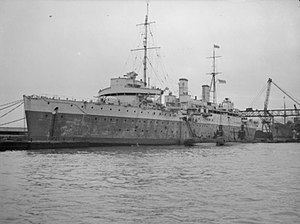Class and type Submarine Depot Ship Laid down 17 August 1936 Fate Scrapped May 1978 Launched 21 October 1937 Weight 9,043 tons Beam 22 m | Commissioned 5 May 1938 Construction started 17 August 1936 Length 152 m Displacement 8.074 million kg Builder John Brown & Company | |
 | ||
Reclassified Internment Holding area, 1970s | ||
HMS Maidstone was a submarine depot ship of the Royal Navy.
Contents
Facilities
She was built to support the increasing numbers of submarines, especially on distant stations, such as the Mediterranean and the Pacific Far East. Her equipment included a foundry, coppersmiths, plumbers and carpenters shops, heavy and light machine shops, electrical and torpedo repair shops and plants for charging submarine batteries. She was designed to look after nine operational submarines, supplying over 100 torpedoes and a similar number of mines. Besides large workshops, there were repair facilities for all material in the attached submarines and extensive diving and salvage equipment was carried. There were steam laundries, a cinema, hospital, chapel, two canteens, a bakery, barber's shop, and a fully equipped operating theatre and dental surgery.
Second World War
In September 1939 Maidstone was Depot Ship to the ten submarines of the 1st Submarine Flotilla. In March 1941 she went to Gibraltar. From November 1942, Maidstone was based at Algiers Harbour, the main Allied base in the Mediterranean. In November 1943 she was assigned to the Eastern Fleet. In September 1944 Maidstone and the 8th Submarine Flotilla were transferred from Ceylon to Fremantle in Western Australia to operate in the Pacific.
In late 1945 Maidstone left Fremantle, and en route to the UK, docked in the Selborne dry dock at Simonstown, South Africa. While on passage, she was diverted to Macassar to pick up 400 British naval prisoners of war from HMS Exeter, HMS Encounter and HMS Stronghold. In November 1945 she arrived at Portsmouth.
During the War Maidstone was adopted by the Borough of Maidstone as part of Warship Week. The plaque from this adoption is held by the National Museum of the Royal Navy in Portsmouth.
Postwar
In 1946 Maidstone became mother ship to the 2nd and 7th Submarine Flotillas. The 2nd Flotilla comprised operational boats, the latter a trials and training squadron. Maidstone had a semi-permanent mooring off Monkey Island (Portland) but often put to sea with her brood. In 1951 Maidstone called briefly at Corunna to land a sick crew man. This was not classified an official visit, although it was the first time a British warship had entered a Spanish harbour since the end of the Spanish Civil War. In 1953 she took part in the Fleet Review to celebrate the Coronation of Queen Elizabeth II.
On 16 June 1955 the submarine HMS Sidon sank in Portland harbour alongside Maidstone 20 minutes after an explosion in the forward torpedo compartment. A rescue party from Maidstone saved a number of the Sidon's crew, but 13 died. A week later, the submarine was raised and the accident was found to be caused by the high-test peroxide fuel in a torpedo. Surgeon Lieutenant Charles Rhodes was posthumously awarded the Albert Medal for his part in the rescue.
In 1956 Maidstone was Flagship of the Commander-in-Chief, Home Fleet. In September 1957, the Russians protested when Maidstone accompanied the training aircraft carrier HMS Ocean on a visit to Helsinki. In 1959 Maidstone received an extensive refit to accommodate nuclear submarines, the 2nd Flotilla was then moved to Devonport. Approx 1961 Maidstone sailed to Faslane, on Gareloch, where she was the depot ship to the 3rd and 10th Submarine Squadrons. In 1965 she undertook a trip to Liverpool, and she visited the same port one year later. She also undertook a trip to Rothesay during this period and then in 1967 she sailed to Rosyth Dockyard to undertake preparations to "mothball" her.
Belfast
In October 1969 Maidstone was refitted and re-commissioned as accommodation for 2,000 troops and sent to Belfast. In 1969 she arrived under tow at Belfast to serve as barracks for the increased security forces in the area. In 1971, she was used as a prison ship in Operation Demetrius as a place to hold internees without trial, including Gerry Adams. The holding area itself was at the stern and consisted of two bunkhouses, one up, one down, and two messrooms. Above these were the rooms of the governor and his staff (previously the captain's cabin) and above this was the deck, used twice a day for exercise. The deck was surrounded by 10-foot-high barbed wire. She was moored in Belfast harbour 20 feet (6.1 m) from the land, entry to the jetty being guarded by sand-bagged army emplacements. Maidstone was also notable for a successful escape by seven Provisional IRA members on 17 January 1972. The men swam close to 300 yards (270 m) through icy water and evaded army and police only to later hold a press conference.
Fate
On 23 May 1978 Maidstone was broken up for scrap at the Thos W Ward scrapyard in Inverkeithing.
